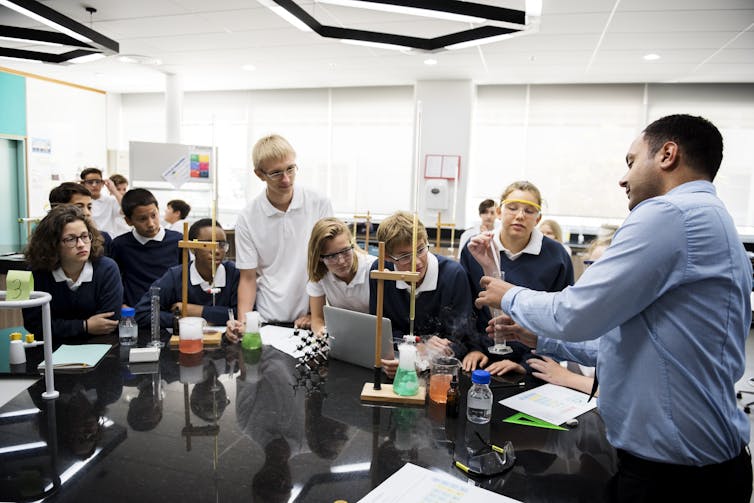
Australian Year 4 students have achieved their best ever result in a major international assessment of maths and science. Year 8 students, who also did the test, held steady.
The results from the 2023 Trends in International Mathematics and Science Study (TIMSS) were released on Wednesday night.
What is TIMSS?
TIMSS runs every four years and has been going since 1995. In 2023, more than 650,000 students from 64 countries did the test.
It isn’t possible to test every Year 4 or Year 8 student (that would take too long and cost too much) so we take a sample. In Australia, this included 13,912 students from 559 Australian schools.
The test was done completely online. It included traditional test items such as multiple choice and short written responses. There were also interactive items where, for example, students could replicate a science experiment in a series of animated on-screen activities.
Students and schools also did questionnaires to give researchers more information about the context in which they are learning.
TIMSS is one of three international assessments in which Australia participates, along with the Progress in International Reading Literacy Study (PIRLS), which looks at Year 4 students’ reading comprehension skills, and the Programme for International Student Assessment (PISA) which looks at 15-year-olds’ skills in maths, science and reading.
This is on top of Australia’s NAPLAN testing of basic literacy and numeracy skills for years 3, 5, 7 and 9.

What has changed?
A lot of the improvement at Year 4 was due to a significant increase in the percentage of very high performing students. These are students who perform at advanced levels for their year level.
In 2023, one in every eight Australian Year 4 students were very high performers in maths and one in every six were very high performers in science.
This contributed to lifting the proportion of students achieving the Australian-set “National Proficient Standard” (where students have to demonstrate more than elementary skills expected at that year level). This has increased by 11 percentage points in Year 4 maths and 12 percentage points in Year 4 science since 1995.
The performance of Year 8 students has not changed significantly since 1995 or since the last test in 2019.
How did we go compared to other countries?
Countries who did the test include the United States, United Kingdom, Japan, Finland and Germany but not China or India.
Singapore was the top performing country overall in both subjects and age groups.
Only four countries outperformed Australia in Year 4 science, while seven countries outperformed us in Year 8 science. In maths, eight countries were ahead in Year 8 and 14 in Year 4.
Boys are outperforming girls
At both Year 4 and Year 8, Australian boys had a higher score than Australian girls in both maths and science. The gender gap in Year 4 maths was one of the largest of the participating countries.
Our improvement at Year 4 since 2019 was also stronger for boys than girls. At Year 8, girls’ performance declined in this time.
Across the board, there was a greater proportion of very high performing boys than girls. For example, one in six Year 4 boys were very high performers in maths compared to one in ten girls.
Previous international assessments have shown girls have less confidence than boys in maths. We also know a students’ self-belief is linked to their achievement.
So we’ll be looking at the student questionnaire responses over the coming months to see if there are any gender differences attitudes and beliefs about science and maths.
What does this mean?
It is worth noting COVID lockdowns happened between 2019 and 2023 tests. Despite these challenges, Australian students have managed to either maintain a good result (at Year 8) or improve (at Year 4).
The strength of the improvement at Year 4 in science suggests efforts to promote STEM in early education are beginning to see results.
We might see this flow through to the middle years when TIMSS is next tested in 2027. This is when the Year 4 group from 2023 will be in Year 8.
By 2027, we would also expect to see the effect of the updated Australian Curriculum that began to roll out in 2023. This has a greater focus on mastering key skills in maths. So we would hope to see an improvement in maths achievement at the lower end of the scale, alongside the strong results of our very high performers that we saw in 2023.
Nicole Wernert does not work for, consult, own shares in or receive funding from any company or organisation that would benefit from this article, and has disclosed no relevant affiliations beyond their academic appointment.
This article was originally published on The Conversation. Read the original article.







